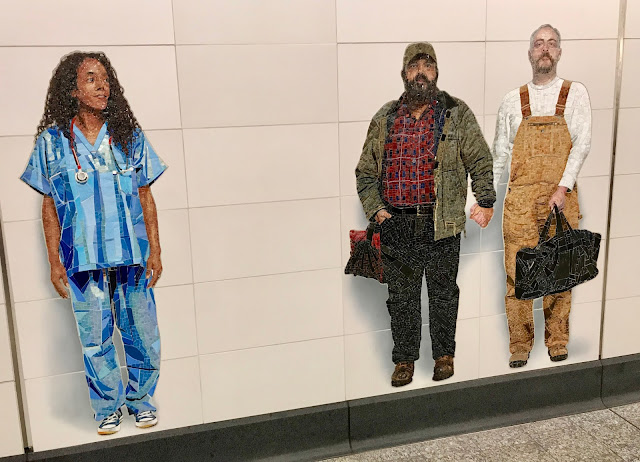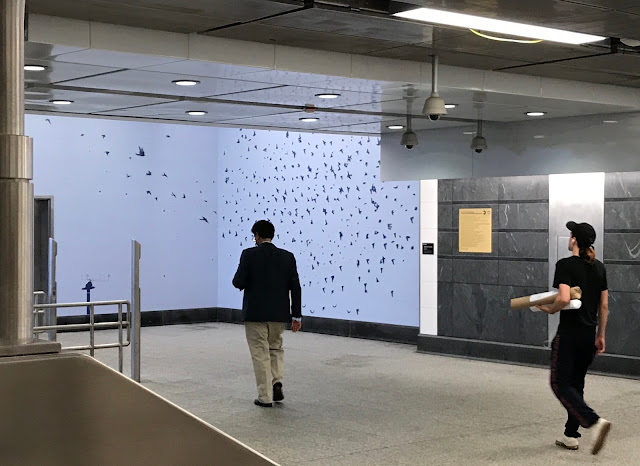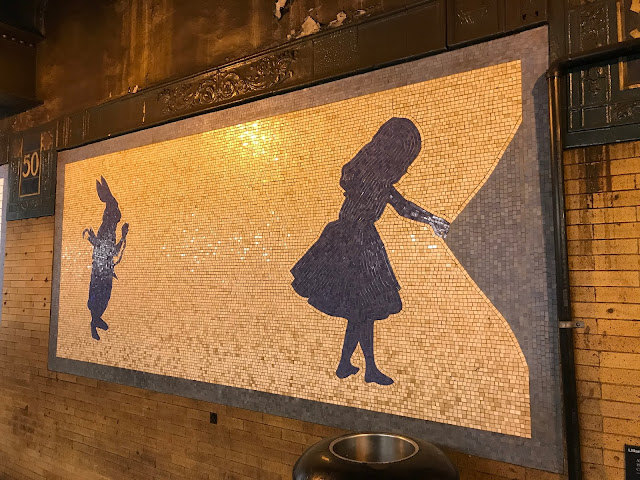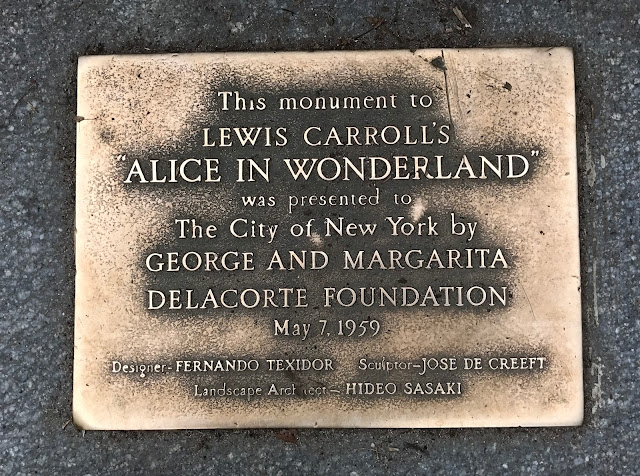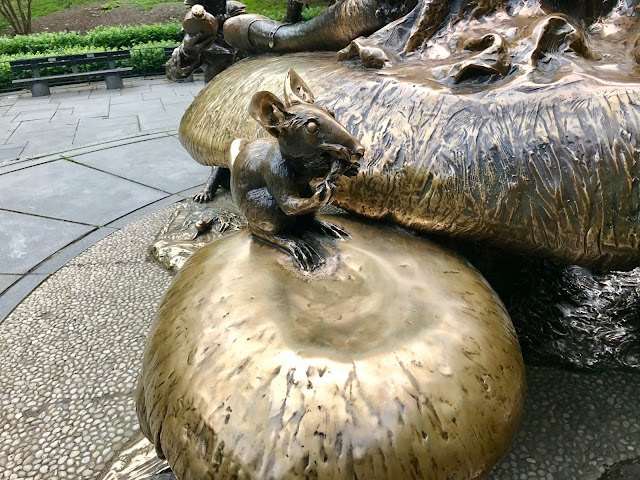These are strange times we're living in.
I am of course referring to the Second Avenue subway, which now actually exists and runs in real life. Well, the first section of it does, anyway. But the fact that any of it is open and operating is really rather remarkable.
The Second Avenue subway was first proposed in 1919 but then not built due to the Great Depression, followed by World War II, and then other funding issues throughout the decades. There were elevated trains that ran along Second and Third Avenues that the subway line was meant to replace. Even though the underground line wasn't built in the 20th century, the elevated lines were destroyed to increase property values, Second Avenue in 1942 and Third Avenue in 1955.
This left just one line on the east side of Manhattan, which is insane. The line's 4, 5 and 6 trains carried 1.3 million people daily as of 2015, easily making it the most used subway line in the country.
The first phase of the new Second Avenue line cost $4.5 billion and opened on January 1, 2017, with the Q train running to new stations at 72nd, 86th and 96th Streets, and also connecting at the station at 63rd and Lexington Avenue.
Phase 2 would extend up to the line's northernmost section in East Harlem, with stations at 106th, 116th and 125th Streets. This phase has only received some initial funding for preparatory planning work but there are no definite dates for construction.
Phase 3 would extend the line all the way down to Houston Street on the Lower East Side, and Phase 4 would go down to its southern end at Hanover Square in the Wall Street area. Phases 3 and 4 don't have funding or any kind of timeline.
It took 98 years between the line being proposed in 1919 and Phase 1 opening in 2017. At that rate, Phase 2 would open in 2115, Phase 3 in 2213, and Phase 4 in 2311. I think the MTA should announce those dates as the planned openings so that any work completed before then would be a pleasant surprise.
The three new stations that opened this year all have the same design and basic layout, with escalators and elevators going down to the turnstiles, followed by a long walkway that runs the length of the station and has stairs leading down to the train platform.
You can see in the photos that "E Pluribus Unum" can be read on one side of a slab that runs over the platform area. The other side says "Excelsior," which is Latin for 'Good luck getting to your destination safely and on time.' Actually it means 'Ever Upward' and is the state motto.
The escalators that run from street level down to the entrances were really long, at least the ones I rode at 72nd and 86th Streets. They reminded me of the escalators in the Washington, D.C. Metro, though maybe they weren't quite that long.
The notable difference among the new stations is the artwork, with each having a different artist's work on display.
At 72nd Street, the artwork is by Vik Muniz and called Perfect Strangers. It is a series of glass mosaic life-size portraits scattered throughout the station that are very realistic and often amusing or quirky in some way. Muniz had people he knows pose as different characters for the portraits and they definitely liven up the station.
Muniz is a Brazilian artist who actually appears as a man fumbling amidst scattered papers (and a calculator). His son also posed as a guy dressed in a tiger suit and holding a plastic bag.
Here are some more of the mosaics followed by a close-up of the tile work.
There is also a mosaic portrait at street level with a balloon flying above. It is just at the entrance to the escalators.
At the opposite corner of the intersection is another entrance to the station, this one without escalators but only a long series of elevators. There was more art here, with a man at street level and birds flying above the elevators. All of these images seemed more photographic than mosaic, so I don't know if they were also by Vik Muniz or a different artist.
The art at the 86th Street station is by Chuck Close and is called Subway Portraits. There are 12 works, 10 in mosaics and 2 in ceramic tiles. The portraits are very detailed and life-like, with each having its own style and some even being out of focus to varying degrees. The subjects are artists, and I admit that I only recognized two of them: a self-portrait and one of Lou Reed, the legendary musician who died in 2013.
Here's a close-up of the self-portrait, where you can get a sense of how many small tiles make up the overall image.
Here are some of the other portraits, including Kara Walker, Cecily Brown and Alex Katz.
At ground level near the escalators is a portrait of Cindy Sherman, very out of focus, and Philip Glass is overhead as people make the escalator descent.
Here is an entrance to the 86th Street station. It's nothing too fancy but it gets the job done.
The art at the 96th Street station does not have any portraits and is more abstract. It is by Sarah Sze and called "Blueprint for a Landscape." It consists of blue and white images that span across the station's different sections and levels, and almost seems like one big illustration that is a mishmash of all the different elements of the city thrown together and in motion.
Here is a look at some of the artwork:
At the other end of the station there were images of birds near the escalators:
And in the concourse there were blowing papers along both sides:
Recent numbers have shown the Second Avenue subway line to be a success thus far, with daily ridership at 176,000 in the first half of May 2017. That is up from 124,000 during its first month of operation in January. Starting this November, the MTA will add an extra Q train to run downtown during the morning rush hour and an extra Q going uptown during the busy evening commute.
More good news is that along with the Second Avenue line growing its numbers, it is easing the burden on 4, 5 and 6 trains at the four closest Lexington Avenue stations: daily ridership overall is down 26 percent and down 40 percent during the morning commuter rush.
That is a bit of welcome positive news for commuters dealing with a subway system that has been in crisis mode of late, not to mention all the problems with other train systems that run into the city. The next phases of the Second Avenue line may be on hold for a while with much of the city's infrastructure dangerously outdated and overwhelmed, but at least Phase 1 is open and making travel more bearable on the east side. And the artwork is pretty cool too.
It's hard to know why a work of art endures and continues to captivate across generations, but Alice in Wonderland has certainly done that, and not just with children and psychedelic enthusiasts. The fantastical, often trippy characters are about as embedded in our collective subconscious as any figures from any stories in the English language.
Lewis Carroll's real name was Charles Lutwidge Dodgson and he was a British mathematician. He wrote Alice's Adventures in Wonderland in 1865 and then its 1871 sequel, Through the Looking-Glass, and What Alice Found There.
The first book recently celebrated its 150th anniversary. The world has changed a lot since 1865, perhaps more than any other stretch of time in human history. In 1865 I don't think they even had the internet.
So why have the stories and their characters endured for so long? I wouldn't know how to begin trying to answer that, but what I do know is that New York City has paid tribute to Alice and co. in a few different ways.
At the 50th Street subway station on the 1 train there are four ceramic mosaics that pay tribute to Carroll's characters, with two on the uptown platform and two on the downtown side. The 1994 works are by Liliana Porter and are called "Alice: The Way Out."
This last one is the most surreal and my favorite of the bunch:
Perhaps the most well-known Alice tribute in the city is the statue in Central Park, near the entrance at East 76th Street and Fifth Avenue.
It is was presented to the city in 1959 by the George and Margarita Delacorte Foundation. The immediate area where the statue is located is called the Margarita Delacorte Memorial.
George Delacorte was a philanthropist who made many other contributions to the city, including the clock near the Central Park Zoo with a carousel of dancing, musical animals.
This statue is a popular tourist spot. When I visited recently there were many people, both adults and children, taking photos and climbing on the figures. A tour group stopped by, and a nearby sign offered information on a free celebrity audio guide from Whoopi Goldberg.
I appreciated the statue's attention to detail, including having ridges on the undersides of the mushrooms.
A third Alice tribute is a very short walk from this statue: just inside the previously mentioned park entrance at East 76th Street is a children's playground that features Alice in Wonderland figures as part of a water spraying fountain.
Coming back to the statue area, it is at the northern edge of a pond called Conservatory Water.
And as a final note, there is a statue of Hans Christian Andersen along the western edge of the pond. He was a Danish writer best known for his fairy tales, which included "The Ugly Duckling," "The Little Mermaid," and "The Emperor's New Clothes."
The open book in the statue shows a passage from "The Ugly Duckling," and there is an inscription on the top hat next to Andersen that credits the architect and sculptor.
There is also an inscription on the back of the statue, which reads, "This monument is the gift of the children of Denmark and New York City and their friends/1956/Sponsored by The Danish-American Women's Association/Baroness Alma Dahlerup founder."
This statue had fewer visitors than Alice and was a quiet area along the water that would be nice to visit or just for a short break during the day. In fact, the entire pond area is relaxing, and the two fairy tale statues certainly add to its charm.
The subway station at 50th Street might not be quite as relaxing, but the Alice mosaics are worth slowing down for if you happen to be passing by.
When spring finally arrives in New York and brings warm weather and nature's bloom, there's nothing like a garden in which to relax and find peaceful solace away from the chaotic streets.
Unless, that is, you suffer from stupid, stupid seasonal allergies. Then it's not as much fun to sit amid all the harmful foliage. I seem to have an issue with tree pollen, which was at high levels for much of May.
But allergies aside, urban gardens are valuable and necessary for mental and spiritual health. This post looks at the garden of the Church of St. Luke in the Fields, which is on Hudson Street in the West Village.
Just inside the entrance is the main garden area, which is a big square bursting with plants, trees and flowers of all kinds. There are stone pathways along the perimeter that also connect to an open central space, and benches scattered throughout.
At the back corner, away from the two abutting streets, Hudson and Barrow, the stone path leads further into the grounds of the church where there is a smaller space with a couple of benches. Beyond that is a final little courtyard with more places to sit, a small grass area, and an old brick wall. This back area is closest to the church building and its school.
I enjoyed the ivy that covered buildings in the front and back areas of the garden.
I tried coming here a few months ago for the blog but there was so much noisy construction around it that I had to leave. This time there wasn't any such noise and the new luxury building nearby seemed to have been completed. There were, however, other signs of ongoing construction. There always seem to be in Lower Manhattan these days.
The West Village has been experiencing rising rents and high-end construction for so many years that it now just seems to be the way things are. Of course these things go in cycles, but who knows how long it will be before prices become more reasonable.
Further up the block on Hudson Street is the church building, which predates all the modern luxury development, having been here since 1820 and experiencing many different iterations of the area.
At its origins the church was on farmland and in a neighborhood that was seen as an escape from the diseases of the city, which was then just the very lowest parts of Manhattan. The church was called St. Luke in the Fields to promote its rural setting.
The West Village has long since been incorporated into the city life of New York, though even with its recent changes it is still a little more relaxed than much of Manhattan and its buildings not quite as towering and domineering. Nevertheless the church's garden now provides a welcome escape for the public from the surrounding blocks and neighborhood.
Hopefully it won't be replaced by luxury offices and apartments any time soon.




